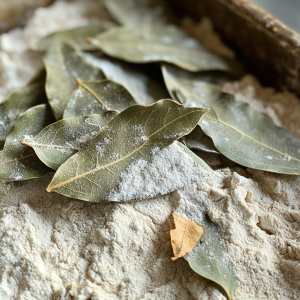
Can bay leaves really repel pests?
Can bay leaves really work as a pest repellent?
There’s very little scientific evidence that bay leaves are effective against pests in our flour and other dry goods, and yet so many people swear by it, including our trusted great-great-grandmothers and all of those in between. In fact, bay leaves have been used as a pest repellent in grains and flours for centuries without one iota of scientific evidence, yet plenty of real-life evidence has perpetuated its use. So, I was curious. I wanted to know WHY! And was it truly effective? In my pursuit of these answers, I decided to see if my knowledge of the essential oil, Bay Laurel, which is the same plant as the bay leaves, Laurus nobilis, and its active constituents, would give me any explanation and success in finding evidence of insect repellent properties there. And I’m tickled to say that I hit pay dirt. In fact, I was astounded to find that there’s an entire industry of commercial pest-repellent products that use the Laurus nobilis essential oil as an active ingredient in their products for pest control! Hmm…maybe there’s something to the reason why they were used as a crown for Roman emperors… but I digress…
The responsible constituents within the essential oil are the major constituents of 1,8 cineole and linalool, as well as a-pinene, which is a minor constituent, as well as β-Pinene, Sabinene, and Methyl eugenol. (There are hundreds more, but these were the focus of my research)

Can bay leaves repel pests?
While bay leaves themselves have NOT been researched, these compounds, particularly 1,8-Cineole and linalool, have been studied exhaustively for their potential insecticidal and repellent properties. Go figure. Some research findings you might come across are studies that have shown that 1,8-Cineole has repellent effects against certain stored product pests. You know, the kind that we worry about in our pantries. Linalool has been found to have repellent and toxic effects on some insects. The combination of these compounds in bay laurel essential oil might have synergistic effects, potentially enhancing its overall repellent properties. Some studies have specifically looked at the effect of bay laurel essential oil on stored product pests like grain weevils and flour beetles.
So do these constituents just repel, or can they eliminate? Let’s look at that. There is an insecticidal effect. Some constituents can have direct toxic effects on insects, potentially eliminating them. However, this effect is usually more pronounced with concentrated essential oils rather than whole bay leaves. There’s also the behavioral disruption component. Certain compounds may interfere with insect behavior, affecting their ability to locate food or mates, which can indirectly lead to population reduction. Lastly, there’s the developmental inhibition consideration. Some studies suggest that exposure to these compounds can affect insect development, potentially preventing eggs from hatching or larvae from maturing.

Bay leaves repel pests
So there you have it. The constituents in the essential oil that comes from bay leaves are known insect repellents and insecticides of those pests that invade our flour and grains. So, can we safely say we can use bay leaves and get the same effects? Well, bay leaves are nowhere near as potent as essential oils, and perhaps that’s a good thing because you don’t want your flour or grain to smell as potent as the essential oil will be. But the bay leaves still contain those same constituents. Bay leaves will lose their potency after a while, but not before they have done their job on the contents of your bucket. And it’s not like you’re introducing more product to the bucket as you go along. So, I say we’ve discovered the reason why bay leaves work so well in flour, grains and pasta. And that was my intent. So Bay Leaf On, my friends.


